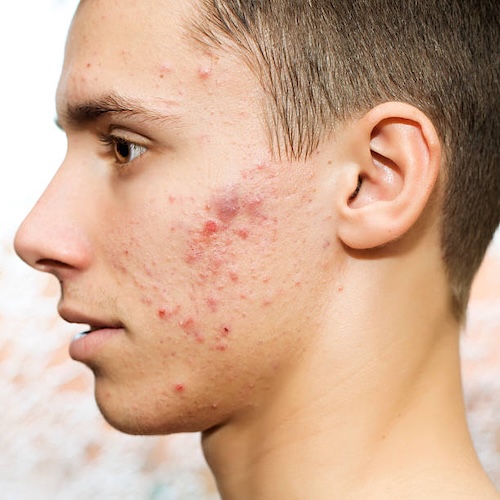Understanding Pimples and the Role of Mollenol
29th Jul 2025
 Take-away: Pimples originate when excess sebum, sticky dead cells and Cutibacterium (Propionibacterium) acnes block a follicle; the plug evolves from an invisible micro-comedone into blackheads/whiteheads and, if inflamed, papules, pustules or deeper cysts. Mollenol® topical that targets several steps in this cascade with natural antimicrobials (eugenol, lauric acid, terpinen-4-ol). Its individual ingredients are supported by published acne research, the finished product itself has not yet been tested in clinical trials.
Take-away: Pimples originate when excess sebum, sticky dead cells and Cutibacterium (Propionibacterium) acnes block a follicle; the plug evolves from an invisible micro-comedone into blackheads/whiteheads and, if inflamed, papules, pustules or deeper cysts. Mollenol® topical that targets several steps in this cascade with natural antimicrobials (eugenol, lauric acid, terpinen-4-ol). Its individual ingredients are supported by published acne research, the finished product itself has not yet been tested in clinical trials.
- How a Pimple Forms
|
Stage |
What Happens |
Key Features |
|
Sebaceous stimulation |
Androgens spike sebum output from sebaceous glands |
Oily shine; occurs at puberty, menses, PCOS [1] |
|
Micro-comedone |
Sticky corneocytes + sebum accumulate inside the follicular infundibulum |
Clinically invisible “seed” of every lesion [2] |
|
Open or closed comedone |
Plug enlarges; if the follicular opening stays shut ➜ whitehead; if it dilates and oxidises ➜ blackhead |
Non-inflamed, skin-coloured or dark dots [3] |
|
Inflammatory transition |
C. acnes thrives in the lipid-rich, low-oxygen duct, hydrolysing triglycerides into pro-inflammatory free fatty acids; immune cells flood in |
|
|
Advanced lesions |
Follicular wall ruptures; contents spill into dermis |
Nodules, cysts, risk of scarring [5] |
Four inter-locking pathogenic pillars are recognised: hyper-seborrhoea, hyper-keratinisation, bacterial overgrowth, and inflammation [6].
- Conventional Ways to Interrupt the Cascade
- Keratolytics (salicylic acid, retinoids)
- Antimicrobials (benzoyl peroxide, topical antibiotics)
- Anti-inflammatories (dapsone, azelaic acid)
- Hormonal modulation (combined oral contraceptives, spironolactone)
Resistance, skin irritation and pregnancy restrictions drive interest in gentler, plant-based adjuncts.
- What Is Mollenol?
- Made in the USA and Australia.
- Over-the-counter topical listed with the Therapeutic Goods Administration (AUST L 235288) [7]
- Two lotions (full-strength and “Sensitive”) + hydrocolloid patches [8][9][10]
- Declared actives: clove bud oil (rich in eugenol/acetyl eugenol), coconut-derived lauric acid, tea tree oil, sandalwood oil [8][11]
- Applied twice daily as a smear ± covered with a patch; avoid broken skin and peri-ocular area [12]
- Scientific Support for Mollenol’s Core Ingredients
|
Plant-derived active (approx. content in Mollenol) |
Mechanism(s) relevant to acne |
Evidence against C. acnes & clinical data |
|
Eugenol (clove oil 60% w/w in full-strength lotion) |
Potent membrane-disrupting bactericide; anti-inflammatory COX-2 inhibition; mild local anaesthetic |
MIC 0.31 mg/mL vs C. acnes; kills by permeabilising cell wall [13] - Significant inhibition zones in multiple in-vitro studies [14] |
|
Lauric acid (from coconut oil) |
Selective lytic action on Gram-positive bacteria; reduces ear-swelling and granulomatous response in vivo |
MIC 1.95 µg/mL (≈15× stronger than benzoyl peroxide); topical or intradermal application cleared murine C. acnes infection without harming keratinocytes [15][16] |
|
Tea tree oil (TTO) (∼0.8% in patches) |
Terpinen-4-ol bactericidal, anti-inflammatory and antioxidant |
Randomised, double-blind RCT: 5% TTO gel cut total lesion count and acne severity 3-6× more than placebo in 60 patients over 45 days [17]; meta-analysis confirms benefit with good tolerability [18][19] |
|
Sandalwood (Santalum spicatum) |
Additional anti-inflammatory and wound-healing sesquiterpenes |
Traditional use; supportive in-vitro data, but limited acne-specific trials |
These actives cover all four pathogenic pillars (keratolysis excepted) and show synergy in laboratory models [20][21]. No published human trial has tested the complete Mollenol formulation; current evidence is extrapolated from its components.
- Practical Use of Mollenol for Pimples
- Cleanse gently and wait 30 min (oil residues block penetration).
- With a fingertip, apply < 1 mg (a thin film) directly on the lesion head; do not rub extensively [12].
- Optional: seal larger, pus-filled bumps with a Mollenol Hydrocolloid Patch for 12-24 h to absorb exudate and shield from picking [9].
- Repeat twice daily until the papule shrinks or opens; then stop and let the site heal to avoid stinging on raw skin [12].
- Patch test first, especially on sensitive or eczematous areas; clove oil can cause irritant or allergic contact dermatitis in < 2% of users [22].
- Avoid use if pregnant/breast-feeding (precautionary), on mucous membranes, or alongside other potent actives (e.g., benzoyl peroxide) at the same time point.
- Expected Outcomes and Limitations
- Users often report faster “head-softening”, reduction in redness and drying of pustules within several days — effects consistent with the pharmacology of eugenol/lauric acid/TTO.
- Because it does not normalise keratinisation or hormones, Mollenol is best positioned as an add-on spot treatment rather than a comprehensive monotherapy for moderate–severe acne.
- Bottom Line
Mollenol harnesses three well-studied botanical antimicrobials that individually match or outperform standard topical agents against C. acnes in laboratory and early clinical studies. Used correctly, it can shorten the lifespan of isolated inflammatory pimples with a low risk of antibiotic resistance. For widespread, nodular or hormonally driven acne, combine it with evidence-based keratolytics or seek professional care.
⁂
- https://www.mayoclinic.org/diseases-conditions/acne/symptoms-causes/syc-20368047
- https://herocosmetics.de/skin-school/how-a-pimple-forms-and-what-derms-recommend-to-treat-acne
- https://en.wikipedia.org/wiki/Comedo
- https://pubmed.ncbi.nlm.nih.gov/28805938/
- https://slmdskincare.com/blogs/learn/the-life-cycle-of-a-pimple
- https://www.sciencedirect.com/science/article/pii/S2405580823001590
- https://www.tga.gov.au/resources/artg/235288
- https://www.mollenol.com/forum/about-mollenol/
- https://www.mollenol.com/mollenol-hydrocolloid-patches/
- https://www.mollenol.com/mollenol-sensitive/
- https://www.mollenol.com/molluscum-treatment-buy-mollenol-for-molluscum/
- https://www.mollenol.com/how-to-use/
- https://jamanetwork.com/journals/jamadermatology/fullarticle/711838
- https://www.medsearchuk.com/blog/clove-essential-oil-an-effective-antibacterial-agent/
- https://pubmed.ncbi.nlm.nih.gov/19387482/
- https://pmc.ncbi.nlm.nih.gov/articles/PMC2772209/
- https://pubmed.ncbi.nlm.nih.gov/17314442/
- https://www.frontiersin.org/journals/pharmacology/articles/10.3389/fphar.2023.1116077/full
- https://pmc.ncbi.nlm.nih.gov/articles/PMC10295805/
- https://pmc.ncbi.nlm.nih.gov/articles/PMC5297807/
- https://jurnalnasional.ump.ac.id/index.php/PHARMACY/article/view/12629
- https://rau-cosmetics.de/en-de/Active-ingredient-lexicon/EUGENOL/
